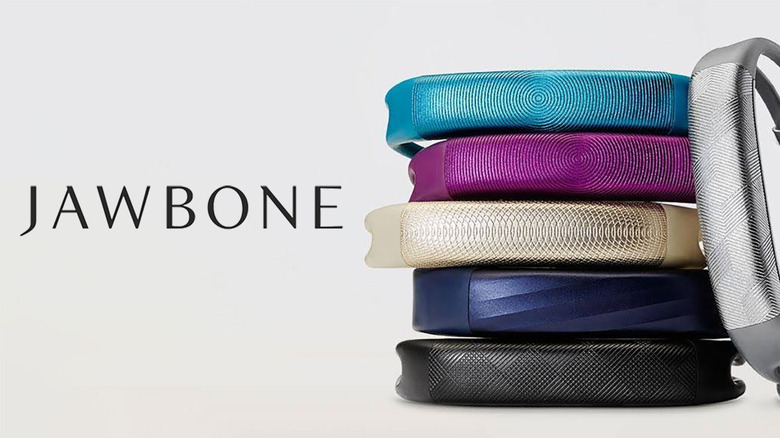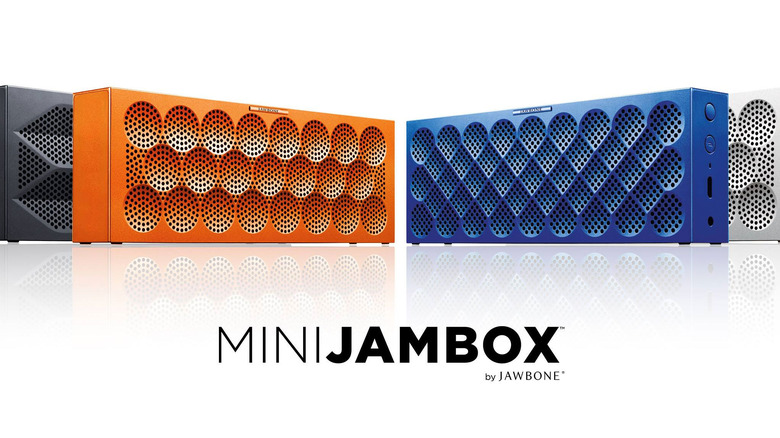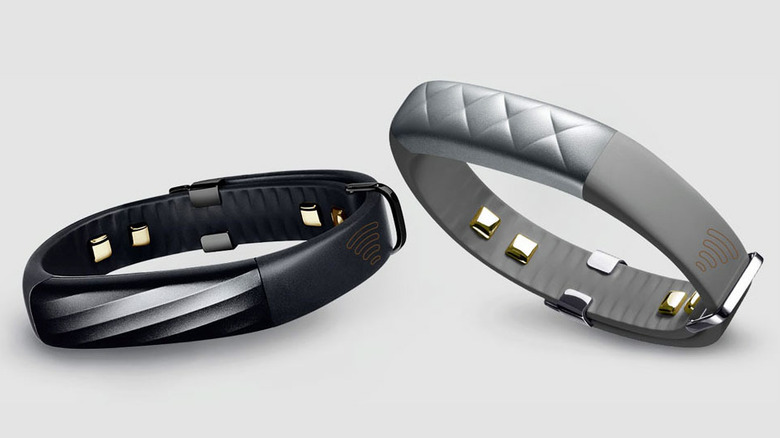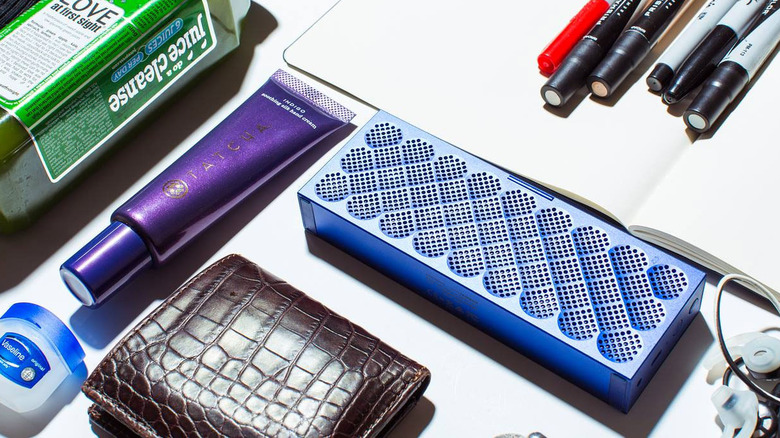What Happened To Jawbone: The Rise And Fall Of The Speaker Brand
We may receive a commission on purchases made from links.
Tech firms funded by venture capital can sometimes go awry, though often, these firms do have good intentions. While a few successful technology firms have been fueled by venture capital, the downfall of large tech firms like Quibi and Airlift indicates that not every company or idea is good. Jawbone, a once highly-touted wireless speaker and wearables brand, is one such case where hype and incredible investment weren't enough to build a sustainable company in the long run.
The story of Jawbone is extensive, paved with the best intentions over a decade to provide innovative new technology in the form of noise-cancellation to consumers. By 2014, the company was valued at a blistering $3.2 billion, but a lack of agility caused it to be one of the most historic cases of a business failure funded by venture capitalists in American history.
Over its 15 years in business, the company managed to raise a total of $929.9 million, mainly based on speculation for future product launches and promises of technological innovation. However, by 2017, the company would go out of business, liquidating the rest of its assets and laying off its workforce in one of the most epic business failures in all of tech history.
Jawbone started as AliphCom
Jawbone was founded by Alexander Asseily and Hosain Rahman in 1999, shortly after meeting at Stanford. Initially dubbed AliphCom, Asseily and Hosain intended to develop voice communication technology that featured better noise suppression than other audio devices on the market. The duo planned on providing this new tech to organizations like the U.S. Navy and DARPA, the Pentagon's research arm. They aimed to develop a headset that would block background noise for soldiers on the battlefield, a technology later dubbed "NoiseAssasin."
In 2007, Aliph would release the Jawbone Bluetooth wireless earpiece, originally for the iPhone and Blackberry, for around $120. The product did exactly as the duo had advertised — provided a handy wireless headset that would block out background noise like wind or crowds in public places. In addition to blocking out background noise, the company's technology would also better detect the wearer's voice and adjust the volume automatically, removing the need to shout on calls.
The wireless headset would come with a noise cancellation shield, boasting what was, at that time, an innovative concept paired with a widely popular device. Later, the company would develop newer iterations of the product in 2008 called the Jawbone 2, then the Jawbone Prime in 2009. While these models were generally praised at the time for their quality and innovation, the company would never be able to go on to establish a dominating foothold in the wireless earbud industry.
Jawbone thrived off investment in the 2010s
Jawbone reached its unicorn status around 2011, officially changing its name from AliphCom to Jawbone. In the same year, Jawbone released its first wireless speaker, the JamBox, which was fairly successful at the time. The company would follow up the success with a bigger, better version of the product called the Big JamBox in 2012. This new iteration offered exceptional battery life and decent sound quality at a $300 cost. This product would be generally received well and sold units for the company.
However, timing is everything, and eventually, other products like the JBL Flip and Bose Bluetooth speakers would completely push Jawbone out of the industry. Despite the stiff competition, the company maintained a total valuation of over $1 billion.
By 2014, the company was valued at around $3.2 billion. This valuation was mostly spurred on by venture capital investment, and the announcement of a new line of wearable devices called Jawbone UP. By 2014, Jawbone would have an 18% market share in the fitness wearables market.
By 2016, investors included titans like Sequoia, Kleiner Perkins Caufield & Byers, and Andreessen Horowitz, but the writing was already on the wall for the company. Co-founder Alexander Asseily stepped away from the company. While much of Jawbone's actual value and liquidity came from venture capital investment, it didn't stop the company from developing new products and taking them to market.
Jawbone's astronomical failure came quickly
In what seemed like an instant, Jawbone's position as a player in the wireless audio and wearables industry would all come crashing down within only three years. The beginning of the end came with its product line of wearables and the Jawbone UP in 2013. Boasting a wide array of functionality like metrics tracking for personal health, vibration alarms, and integration with Android and iPhone devices, it already had stiff competition via the Fitbit One.
By the time the Jawbone UP 3 came out in 2015, there was even more competition from the Apple Watch, Fitbit, and third-party wearable companies. Furthermore, the underwhelming technology of the wearable caused the device to be received poorly by the public. Notably, the device was unable to accurately test heart rate, something that had originally set it apart from competitors. It also lacked a viewable face, something its main competitors featured, leaving users to rely on another smart device rather than the Jawbone alone.
At this point, the company had put more emphasis on wearable devices, as less emphasis was put on its audio product offerings, though its final wireless earbud, the Jawbone ERA, was released one year later, in 2014. By 2015, the company's market share in the fitness tracker market had slid to a mere 8%, and by 2016, that would slip even further to a minuscule 2%. In 2017, Jawbone shuttered as the remaining co-founder, Hosain Rahman, moved on to another company.
Jawbone could never compete in any industry
Investment would, ironically, also start Jawbone's unraveling from a valuation perspective. In 2015, Jawbone secured a $300 million loan from BlackRock and Rizvi Traverse Management, which dropped its valuation to under $2 billion. When the company sought more capital in the following year to continue operations, Jawbone's company valuation was all but shattered, and confidence in the company was at an all-time low.
Ultimately, Jawbone could never claim the top status in any industry. While it was one of the first noise-canceling wireless earbuds ever to be on the market, companies like Apple, LG, and Sony would go on to dominate in the space. In terms of wireless speakers, companies like Bose, Samsung, and JBL would go on to dominate the market, leaving little room for Jawbone to compete. Its wearables also failed, as Fitbit would dominate that industry, with a market share of 37.9% in 2014, according to Statista. Eventually, other major brands, notably Apple, would also enter the arena.
While Jawbone foresaw trends that persist to this day, much of its value had been propped up by outside investment, and bigger companies with better quality products and a clearer vision would eventually dwarf each of its product launches. While bad timing or lack of manufacturing capabilities could be blamed, much of Jawbone's woes can be placed on the stiff competition it faced in every industry.




